
Jail vs. Prison: Understanding the Key Differences
The terms “jail” and “prison” are often used interchangeably, leading to confusion about their distinct purposes and functionalities within the criminal justice system. While both are correctional facilities where individuals are confined, significant differences exist regarding the length of stay, the types of offenders housed, and the managing authority. Understanding the nuances between a jail and a prison is crucial for comprehending the complexities of law enforcement and the penal system.
Defining Jails and Prisons
What is a Jail?
A jail is a local or regional correctional facility primarily used for short-term detention. It serves several key functions, including:
- Holding individuals awaiting trial or sentencing.
- Detaining those convicted of minor crimes, typically misdemeanors, with sentences of a year or less.
- Temporarily housing individuals awaiting transfer to other facilities, such as prisons.
- Holding individuals arrested for violating probation or parole.
Jails are typically operated by city or county governments, and their primary focus is on short-term confinement and processing of individuals within the local criminal justice system. The conditions in jails can vary widely, but they often face challenges due to overcrowding and limited resources. Many individuals who find themselves in jail are awaiting trial and have not yet been convicted of a crime. This is a crucial distinction.
What is a Prison?
A prison, on the other hand, is a state or federal correctional facility designed for long-term incarceration. Prisons house individuals convicted of more serious crimes, typically felonies, with sentences exceeding one year. The primary purpose of a prison is to punish offenders and rehabilitate them through various programs and services.
Prisons are operated by state or federal governments and are generally larger and more secure than jails. They offer a wider range of programs and services, including educational opportunities, vocational training, and substance abuse treatment. Prison life is generally more structured than jail, with strict rules and regulations governing inmate behavior. The goal is to maintain order and security within the facility while also providing opportunities for inmates to improve their lives.
Key Differences Between Jails and Prisons
To further clarify the distinctions between these two types of correctional facilities, let’s delve into the key differences:
Length of Stay
This is perhaps the most significant difference. Jails are designed for short-term stays, typically less than a year. Individuals in jail may be awaiting trial, serving sentences for misdemeanors, or awaiting transfer to another facility. Prisons, conversely, are for long-term incarceration, housing individuals serving sentences for felonies that exceed one year. The extended stay allows for more comprehensive rehabilitation programs and a more structured environment.
Types of Offenders
Jails house a diverse population, including individuals awaiting trial, those convicted of misdemeanors, and those awaiting transfer. This means that jails often contain a mix of individuals with varying levels of criminal history and risk. Prisons, however, primarily house individuals convicted of felonies, which are more serious crimes. This allows prisons to focus on specific rehabilitation programs tailored to the needs of felony offenders. The segregation of offenders based on the severity of their crimes is a key factor in maintaining safety and security within both types of facilities.
Managing Authority
Jails are typically operated by city or county governments, often under the authority of the local sheriff’s department. This means that jails are subject to local laws and regulations. Prisons, on the other hand, are operated by state or federal governments, subject to state or federal laws and regulations. The funding and oversight of these facilities also differ significantly, with state and federal prisons often having larger budgets and more specialized resources.
Purpose and Focus
The primary purpose of a jail is short-term detention and processing. Jails focus on holding individuals awaiting trial, serving short sentences, or awaiting transfer. While some jails may offer limited programs, their primary focus is on security and maintaining order. Prisons, however, have a broader focus that includes punishment, rehabilitation, and deterrence. Prisons offer a range of programs and services aimed at helping inmates change their behavior and prepare for re-entry into society. These programs can include educational opportunities, vocational training, substance abuse treatment, and mental health services. The emphasis on rehabilitation distinguishes prisons from jails.
Conditions and Resources
Jails often face challenges due to overcrowding and limited resources. This can lead to substandard living conditions, inadequate medical care, and limited access to programs and services. Prisons, while also facing challenges, generally have more resources and better facilities than jails. Prisons are typically larger and more secure, with dedicated staff and specialized units for different types of offenders. The availability of resources and the quality of conditions can significantly impact the well-being and rehabilitation potential of inmates in both jails and prisons.
The Gray Areas
While the distinctions between jails and prisons are generally clear, there are some gray areas. For example, some local jails may contract with state or federal authorities to house inmates serving longer sentences. This can blur the lines between the two types of facilities. Additionally, some state prisons may operate short-term detention units that function similarly to jails. Despite these exceptions, the fundamental differences in length of stay, types of offenders, managing authority, and purpose remain the key distinguishing factors.
The Impact on Inmates
The differences between jails and prisons can have a significant impact on the inmates housed within them. The short-term nature of jail confinement can be disruptive and stressful, particularly for individuals awaiting trial who face uncertainty about their future. The lack of programs and services in many jails can also limit opportunities for personal growth and rehabilitation. In contrast, the longer sentences served in prisons allow for more structured routines and access to programs that can help inmates address their underlying issues and develop skills for a successful re-entry into society. However, the challenges of prison life, including violence, overcrowding, and social isolation, can also have a negative impact on inmates’ mental and physical health. [See also: Mental Health in Correctional Facilities].
The Role of Jails and Prisons in the Criminal Justice System
Both jails and prisons play crucial roles in the criminal justice system. Jails serve as the entry point for many individuals accused of crimes, providing a temporary holding place while cases are processed. Prisons provide long-term confinement for those convicted of serious offenses, serving as a deterrent to crime and a means of protecting society. The effectiveness of both types of facilities in achieving these goals is a subject of ongoing debate. [See also: The Effectiveness of Incarceration].
Conclusion
In summary, while the terms jail and prison are often used interchangeably, they represent distinct types of correctional facilities with different purposes and functions. Jails are local or regional facilities for short-term detention, while prisons are state or federal facilities for long-term incarceration. Understanding these differences is essential for comprehending the complexities of the criminal justice system and the challenges faced by both inmates and correctional staff. The distinction between a jail and a prison is more than semantic; it reflects fundamental differences in the goals, resources, and impact of these institutions. By recognizing these nuances, we can better understand the realities of incarceration and work towards a more just and effective criminal justice system.

